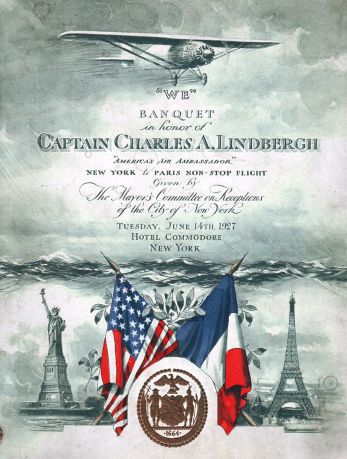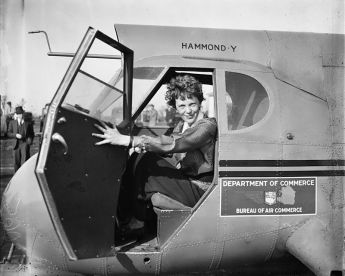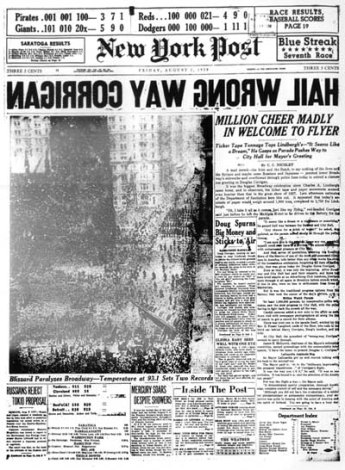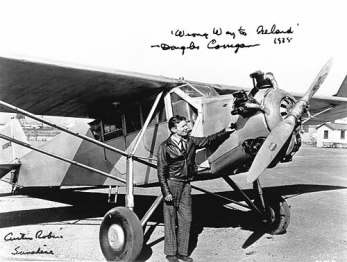In the period between the two World Wars, the Wright brothers’ first flight at Kittyhawk was well within living memory. The flying Aces of the Great War seemed like some kind of modern-day knights, and many became pop-culture heroes. Wood-and-fabric biplanes gave way to sleek, metal monoplanes, while air races and daring, record-setting flights seemed a constant feature of the daily news.
Heavier-than-air flight, once considered an impossibility, was coming of age.
 The first non-stop transatlantic flight in history began on June 14, 1919, when British aviators John Alcock and Arthur Whitten Brown departed St. John’s, Newfoundland in a modified bomber, arriving in Ireland the following day.
The first non-stop transatlantic flight in history began on June 14, 1919, when British aviators John Alcock and Arthur Whitten Brown departed St. John’s, Newfoundland in a modified bomber, arriving in Ireland the following day.
Charles Lindbergh’s better known (and longer) New York to Ireland flight began in the early morning hours of May 20, 1927, when the custom-built, linen-skinned Ryan Aeronautical Company monoplane Spirit of St. Louis departed Roosevelt Field on Long Island, New York.
33½ hours later, thousands of spectators’ cars were caught up in “the largest traffic jam in Paris history”, to be there for the landing at Le Bourget Aerodrome.
Five years later to the day, Amelia Earhart performed the first nonstop transatlantic crossing by a female pilot, completing the 2,000 mile crossing from Newfoundland to Ireland, in fifteen hours.
 Five years later, “Lady Lindy” disappeared over the South Pacific, along with copilot Frederick J. Noonan.
Five years later, “Lady Lindy” disappeared over the South Pacific, along with copilot Frederick J. Noonan.
Few events so captured the world’s imagination, as the Earhart search of 1937, and the explosion aboard the Apollo spacecraft, in 1970. On both occasions, breathless headlines the world over followed the unfolding drama.
The Apollo 13 story had a happy ending, as astronauts James Lovell, John Swigert and Fred Haise returned safely, to earth. It was thirty-three years since the Earhart disappearance, a mystery which remains unsolved, to this day.
The 1920s – 30s have been described as the “Golden Age of Aviation”. This was the world of Douglas Corrigan.

At the age of eighteen, Corrigan forked over $2.50 for a ride on a Curtiss Jenny biplane. He was hooked. He began flying lessons a week later, making his first solo flight on March 25, 1926.
A man without the means or the fame of Charles Lindbergh, Douglas Corrigan brought himself up in the aviation world, with his hands. He was an aircraft mechanic, and a good one.
It was Corrigan who assembled the wing and installed the fuel tanks and instrument panel, for Lindberg’s Spirit of St. Louis. Corrigan and colleague Dan Burnett increased the lift of the aircraft, extending the wing an additional 10-ft. longer than any earlier Ryan-designed aircraft.
Following Lindbergh’s success, Corrigan set his sights on a transatlantic crossing of his own. Working as an aircraft mechanic with the Airtech Flight School in San Diego, Corrigan would work on his flight skills, during short lunch breaks. He would perform aerobatic stunts with company aircraft, much to the chagrin of his employer. He continued to perform stunts after the company prohibited the practice, simply a little south, where the boss couldn’t see him.
Corrigan worked several jobs as aircraft mechanic, always using his employer’s planes to hone his flying skills.
In 1933, Corrigan paid $310 for a used 1929 Curtiss Robin monoplane, and began to modify it for transatlantic flight. He scavenged the parts from two old Wright Whirlwind engines, increasing the aircraft’s horsepower from 90 to 165. He installed additional fuel tanks and applied to the Bureau of Air Commerce in 1935, for permission to make the flight. The application was rejected.
 Corrigan made additional modifications and repeated applications over the next two years, all of which were rejected. By 1935, the once-freelance aviation industry faced increasing government regulation. Corrigan found his project losing ground. . In 1937, federal officials not only rebuffed his flight plan. Authorities deemed Corrigan’s aircraft Sunshine unstable for safe flight, and denied renewal of its license to fly.
Corrigan made additional modifications and repeated applications over the next two years, all of which were rejected. By 1935, the once-freelance aviation industry faced increasing government regulation. Corrigan found his project losing ground. . In 1937, federal officials not only rebuffed his flight plan. Authorities deemed Corrigan’s aircraft Sunshine unstable for safe flight, and denied renewal of its license to fly.
That was it. If he couldn’t get the permit, he’d do it without.
Corrigan flew in from California, arriving in Brooklyn unannounced and nauseous from a fuel leak. All was confusion at the time, with Howard Hughes preparing to take off on a world tour. Corrigan filed his flight plan for a return trip to California and headed out at first dawn on July 17, 1938, headed east with two chocolate bars, a couple boxes of fig bars, and a quart of water.
This was not the well-backed, bountifully financed custom aircraft of the Lindbergh days. This was the soapbox derby of airplanes, literally held together with baling wire and a quiltwork of patches, welded to the hood. Let journalist H. R. Knickerbocker, pick up the story:
“You may say that Corrigan’s flight could not be compared to Lindbergh’s in its sensational appeal as the first solo flight across the ocean. Yes, but in another way the obscure little Irishman’s flight was the more audacious of the two. Lindbergh had a plane specially constructed, the finest money could buy. He had lavish financial backing, friends to help him at every turn. Corrigan had nothing but his own ambition, courage, and ability. His plane, a nine-year-old Curtiss Robin, was the most wretched-looking jalopy…The door behind which Corrigan crouched for twenty-eight hours was fastened together with a piece of baling wire. The reserve gasoline tanks put together by Corrigan, left him so little room that he had to sit hunched forward with his knees cramped, and not enough window space to see the ground when landing”.
Ten hours into the flight, Corrigan discovered his ‘cold feet’ were the result of gasoline, sloshing around the cockpit. He poked a hole with a screwdriver, and kept going. 26 hours in, he claimed to have discovered a “navigation error”. The Robin was still over water. 28 hours and 13 minutes after leaving Brooklyn, Corrigan touched down at Baldonnel Aerodrome, in Dublin.
 Aviation officials were apoplectic that a New York to California flight plan, would wind up in Ireland. At a time when Western Union charged by the word, the pilot was excoriated with a 600-word diatribe, enumerating the pilot’s transgressions. Corrigan served a 14-day suspension of his flying license, ending the day he returned with his aircraft aboard the steamship Manhattan.
Aviation officials were apoplectic that a New York to California flight plan, would wind up in Ireland. At a time when Western Union charged by the word, the pilot was excoriated with a 600-word diatribe, enumerating the pilot’s transgressions. Corrigan served a 14-day suspension of his flying license, ending the day he returned with his aircraft aboard the steamship Manhattan.
“Wrong Way” Corrigan returned to a ticker-tape parade, larger than the one given Lindbergh, himself.
The flight mechanic was a celebrity, writing an autobiography and endorsing a line of “Wrongway” products, including a watch that ran backward. He appeared on a 1957 episode of To Tell the Truth, and earned $75,000 portraying himself in the RKO film, The Flying Irishman. It would have taken thirty years to earn that much, at any of his airfield jobs.
To his great disappointment, Charles Lindbergh, Corrigan’s hero and the reason he had made the flight in the first place, never acknowledged his feat.
 Wrong Way Corrigan flight tested bombers during WW2 and retired in 1950, and bought an orange grove in Santa Ana, California. He claimed he knew nothing about growing oranges, he just copied what his neighbors were doing.
Wrong Way Corrigan flight tested bombers during WW2 and retired in 1950, and bought an orange grove in Santa Ana, California. He claimed he knew nothing about growing oranges, he just copied what his neighbors were doing.
The old Robin came out of its hangar one last time on the golden anniversary of the flight, reassembled and the engine restarted, successfully. Corrigan became so excited that event organizers placed guards at the aircraft’s wings – they even considered tying the tail to a police car – fearful that the old man would once again, take off in the thing.
At age 84, Douglas Corrigan was elected an Honorary Member of the ‘Liars Club of America’, an honor which he politely, but firmly, refused. To the end of his days, Wrong Way Corrigan insisted that his transatlantic flight was nothing more than a navigation error. He was as surprised to find himself in Ireland, as anyone else.
The autobiography is out of print but still available, if you’re interested. It’s about fifty bucks, in hard cover, the title is That’s my Story.
If you enjoyed this “Today in History”, please feel free to re-blog, “like” & share on social media, so that others may find and enjoy it as well. Please click the “follow” button on the right, to receive email updates on new articles. Thank you for your interest, in the history we all share.



That’s certainly one heck of a navigational error! There may be more to this than a simple ‘mistake’. He sounds like a real character and one who oddly enough, deserved the recognition!
LikeLiked by 1 person
I agree, I found myself liking the guy as I got to know him.
LikeLiked by 1 person
Me too! Quite a character.
LikeLiked by 1 person
An excellent article about a lesser known aviator. Thanks for sharing it with us! I love the the WrongWay products haha. What a good sport.
LikeLiked by 1 person
I’m more than a little tempted to buy the man’s autobiography. I think he’s a guy that I would’ve gotten along with, and if I’d ever met the man.
LikeLiked by 1 person
From the jolly smile in his pictures I’d say it would be hard to not get along with him! I’d love to read his book too. I might try and get my hands on it somehow.
LikeLiked by 1 person
There are used copies of the hard cover available on Amazon. It must be popular, the book itself is about 48 bucks with another seven or eight dollars in shipping.
LikeLiked by 1 person
I really like this guy. That took guts and spirit. Thanks for the info…
I can’t help it…when I read the title the first thought in my head was “Wrong Way Feldman” from Gilligans Island…
LikeLiked by 1 person
There was a center who recovered a fumble in the 1929 Rose Bowl and defeated his own team when he ran the ball back in the wrong direction. For a second, I thought you were going there.
LikeLiked by 1 person
You got me curious…Roy Riegels…
I have big respect for Corrigan…I’m reading some things about him now…thanks for the story.
LikeLiked by 1 person
I have Mr Riegels tee’d up for New Year’s Day. The story is a lot of fun now, but I’m sure it was no fun at all that day in 1929.
LikeLiked by 1 person
No fun at all at the time… Vin Scully once said that he always prayed before playoff games that there would be no “goats” so to speak. Like Bill Buckner or Willie Davis…one bad play that defined their career.
LikeLiked by 1 person
That’s a sore subject, in this part of the world. Do you know what Bill Buckner and Michael Jackson have in common? They both wear one glove for no apparent reason.
LikeLiked by 1 person
Lol I never heard that! I’ll remember that one.
It was a shame…cause Buckner was a good ball player…
LikeLiked by 1 person
I agree. He’s a lot better than what he is remembered for.
LikeLiked by 1 person
I hope 2004 took some weight off of him anyway.
LikeLiked by 1 person
There was nothing in the world like that World Series. Not even the 1980 Olympic hockey victory over the Evil Empire. Babies were born, grew up and died of old age between Red Sox World Series victories, it was the longest drought in history, short of the 106 years the long suffering cubbies went through. Yeah, we could go through another 86 year drought but,Nobody will ever take 2004 away from us.
LikeLiked by 1 person
I don’t think that will happen again to the Red Sox. The Dodgers are on a 30 year wait but that is nothing compared to what the Sox and Cubs went through…
LikeLiked by 1 person
I even got hot & bothered about the Cubbies championship year, and I couldn’t care less about Chicago. I did one of my “today in history“ essays on the curse of the Billygoat. The history geek in me could not resist that story and I loved every minute of the series. I even watched the 17 minute rain delay.
LikeLiked by 1 person
I really thought they were going to blow it at the end… They nearly did…
LikeLiked by 1 person